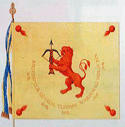

Copyright © Hans Högman 2019-05-20
Swedish Regiments of
the Allotment System -
Infantry (7)
Infantry Regiments:
1. Swedish Regiments -
Infantry (7)

Swedish name: Livregementets
grenadjärer, I3
In 1791 the Mounted Life Regiment
(Livregementet till häst) were converted
into a brigade and divided into three corps:
1.
The Cuirassier Corps of the Life Regiment Brigade
(Livregementsbrigadens kyrassiärkår)
2.
The Hussar Corps of the Life Regiment Brigade
(Livregementsbrigadens lätta dragonkår)
3.
The Light Infantry Battalion of the Life Regiment
Brigade (Livregementsbrigadens lätta
infanteribataljon)
The Cuirassier Corps of the Life Regiment Brigade
later became Life Regiment Dragoons (Livregementets
dragoner, K2).
The Hussar Corps of the Life Regiment Brigade later
became Life Regiment Hussars (Livregementets
husarer, K3).
The Light Infantry Battalion of the Life Regiment
Brigade later became Life Regiment Grenadiers
(Livregementets grenadjärer, I3).
The three corps of the brigade mentioned above
received a status of independent corps in 1815.
The Light Infantry Battalion of the Life Regiment
Brigade received the new name "Grenadier Corps of
the Life Regiment Brigade" (Livregementetbrigadens
grenadjärkår) in 1808 and in 1815 they received the
name Life Regiment Grenadier Corps (Livregementets
grenadjärkår).
The Life Regiment of Foot (Livregementet till fot, I3)
was established in 1893 as the result of a merger of
the Life Regiment Grenadier Corps (Livregementets
grenadjärkår) and the Närke Regiment.
At this time the Fellingsbro "rotar" of the Kungsör
Company of the Västmanland Regiment was
transferred to the new Life Regiment of Foot.
In 1904 the regiment received the name Life
Regiment Grenadiers (Livregementets grenadjärer,
I3).
The Life Regiment Grenadier Corps (Livregementets
grenadjärkår) was allotted with 500 "rotar" in 1815.
Hence, the Regiment had 500 soldiers organized
into 4 companies. The regiment's "rotar" were
located within the provinces of Västmanland and
Södermanland (375 in the county of Västmanland, 14
in the county of Stockholm and 111 in the county of
Södermanland).
Companies 1815, The Life Regiment Grenadier
Corps:
1.
Life Company
2.
Östra Västmanland Company
3.
Södermanland Company
4.
Kungsör Company
Location of the primary Garrison of the
Regiment: From 1912, Örebro. Training camp: From
1767 Sannahed
The Official Colors of the Life Regiment
Grenadiers: White and light blue
Regimental Motto: Artibus et armis recuperatur gloria
(Vetande och vapen skänker ära).
Companies 1893:
1.
Life Company
2.
Södermanlands Company
3.
Kungsörs Company
4.
Örebro Company
5.
Östra Närkes Company
6.
Askersunds Company
7.
Västra Närkes Company
8.
Kristinehamns Company
Victorious Battle Campaigns (segernamn), the
Life Regiment Grenadiers:
•
Lützen
1632
•
Oldendorf
1633
•
Wittstock
1636
•
Leipzig
1642
•
Warszawa
1656
•
Fredriksodde
1657
•
Tåget över Bält
1658
•
Lund
1676
•
Landskrona
1677
•
Narva
1700
•
Düna
1701
•
Kliszow
1702
•
Fraustadt
1706
•
Holovczyn
1708
•
Malatitze
1708
•
Helsingborg
1710
•
Gadebusch
1712
•
Svensksund
1790
Swedish name: Värmlands
fältjägarkår, I26
The regiment was first established in
1790 as the Värmland Rifle Battalion
(Värmlands fotjägarbataljon). The
battalion was an enlisted unit.
The battalion was established in order to defend the
Swedish border towards the Danish Norway. The
battalion was organized in 3 companies with 100
soldiers each. In the beginning the battalion was
subordinated the Närke-Värmland Regiment.
Circa 150 of the battalion was permanently
garrisoned in the city of Karlstad, Värmland until
1796.
In 1812 the battalion was extended with a second
battalion and reorganized into a regiment end
received the name Värmland Rifle Regiment
(Värmlands fältjägarregemente, I26). The regiment now
numbered 600 soldiers.
In 1876 the regiment was reorganized into a corps,
Värmland Rifle Corps (Värmlands fotjägarkår).
The corps was disestablished in 1901. The former
Värmland Rifle Corps was then merged with Halland
Battalion (I28) in 1902 and formed the new regiment
Waxholm Grenadier Regiment (Waxholms
grenadjärregemente, I26).
In 1928 this regiment became a part of the Göta Life
Guard Regiment (Göta livgarde) as this regiment's first
battalion.
Location of the primary Garrison of the Värmland
Rifle Corps: From 1790 Karlstad, 1817 Varpnäs mo,
1832 Trossnäs fält.
Location of the primary Garrison of the Waxholm
Grenadier Regiment: 1902 Stockholm, from 1906
Rindön, west of the city Vaxholm.
Halland Battalion, I28 was estblished in 1813 as the
Halland Conscript Battalion (I28) and numbered 600
men, 1818 Halland Infantry Battalion, 1887 Hallands
Battalion. Training camp: Varberg, from 1833 in
Halmstad and from 1857 Skedalahed.
Swedish name: Karlskrona
grenadjärregemente, I7
Karlskrona Grenadier Regiment was
established in 1902 as the result of a
merger of Småland Grenadier Corps
(Smålands grenadjärkår) and Blekinge Battalion
(Blekinge bataljon).
The Blekinge Battalion had been established in 1887
and was a result of a reorganization of the former
Marine Regiment.
The history of the Småland Grenadier Corps goes
back the Småland Cavalry Regiment.
Karlskrona Grenadier Regiment was garrisoned
in the city of Karlskrona (the major Swedish naval
base). The regiment had its training camp at
Rosenholm.
The regiment was disestablished in 1928. This year
the regiment was transferred to Kronoberg Regiment,
I11, as this regiment's 3rd battalion.
Swedish name: Blekinge bataljon, I30
Blekinge Battalion was established in 1887 and was
a result of a reorganization of the former Marine
Regiment.
The Marine Regiment was established in 1845 as a
result of a reorganization of the former Sea Artillery
Regiment. The Sea Artillery regiment had been
established in 1832.
The Marine Regiment was transferred from the Navy
to the Army in 1871.
Blekinge Battalion was disestablished in 1901 when
the battalion was transferred to the Karlskrona
Grenadier Regiment.
Location of the primary Garrison of the
Regiment: 1890 Bredåkra, 1891 Ronneby.
Former Cavalry Regiments
Reorganized into Infantry
Prior to the Great Nordic War (1700 - 1721) Sweden
had an Army dimensioned to defend the territory of
the Great Power Period. In the peace treaty of 1721
Sweden had to surrender all the Baltic provinces to
Russia.
After the war a lot of infantry regiments was
disestablished and the size of the Army was cut
down to reflect the territory of Sweden in 1721.
However the cavalry regiments were kept at the
same number as they were before the war.
At the end of the 18th century also the cavalry was
downsized. A few cavalry regiments was then
dismounted and organized into infantry. The
dismounted cavalrymen were still provided by the
"rusthåll" and not by "rote"-farmers.
Swedish name: Andra
livgrenadjärsregementet, I5
The regiment was established in 1636 as the
Östgöta Cavalry Regiment (Östgöta
kavalleriregemente) The regiment was linked to the
Allotment System in 1689.
The regiment was dismounted in 1791 and
reorganized as an infantry regiment.
For more information, see Östgöta Cavalry Regiment.
Swedish name: Bohusläns regemente, I17
The regiment was established in 1720 as the
Bohuslän Cavalry and Dragoon Regiment
(Bohusläns kavalleri- och dragonregemente). In 1727
the regiment received the name "Bohuslän Dragoon
Regiment" (Bohusläns dragonregemente) and in 1776
they received the name "Bohuslän Light Dragoon
Regiment" (1776 Bohusläns lätta dragonregemente).
The regiment had two battalions, the South and the
North battalion. In 1776 the North Battalion was
reorganized into an infantry battalion.
Also the South Battalion was reorganized into an
infantry battalion, but not until 1791. The
regiment now received the name "Bohuslän
Regiment" (Bohusläns regemente).
For more information, see Bohuslän Dragoon
Regiment.
Swedish name: Västgöta regemente, I6
The regiment was established in 1628 as Västgöta
Mounted Regiment (Västgöta regemente till häst).
From 1655 Västgöta Cavalry Regiment. The regiment
was linked to the Allotment System in 1691.
The regiment was dismounted in 1811 and
reorganized as an infantry regiment. The regiment
then received the name "Västgöta Regiment"
(Västgöta regemente).
The regiment was disestablished in 1927.
For more information, see the Västgöta Cavalry
Regiment.
Swedish name: Smålands grenadjärkår, I7
The regiment was established in 1543 as the
Småland Mounted Regiment (Smålands ryttare).
From 1684 the regiment carried the name Småland
Cavalry Regiment. The regiment was linked to the
Allotment System in 1695.
The regiment was divided in 1821. The regiment then
carried the name "Småland Dragoon Regiment"
(Smålands dragonregemente).
The first battalion remains as a cavalry unit and
received the name "Småland Dragoon Regiment".
In 1822 this regiment received the name "Småland
Hussar Regiment" (Smålands husarregemente). The
Småland Hussar regiment was disestablished in
1927.
The second battalion was reorganized into infantry
and received the name "Infantry Battalion of the
Småland Dragoon Regiment". In 1824; Småland
Grenadier Battalion (Smålands grenadjärbataljon), in
1888 the Småland Grenadier Corps (Smålands
grenadjärkår).
The Corps was disestablished in 1901 when Småland
Grenadier Corps was merged with Blekinge Battalion
and in 1902 formed the new regiment: Karlskrona
Grenadier Regiment (Karlskrona
grenadjärregemente).
Training camp, Smålands Grenadier Corps: From
1834 Kvarnarp, from 1834 Ränneslätt.
For more information of the dragoon regiment, see
the Småland Cavalry regiment.
Related Links
•
The Allotment System
•
Swedish Wars
•
The Navy & the Army Fleet
•
Swedish Military Unit Designations
•
Swedish Military Branch and Unit Insignias
•
Uniforms of the Swedish Army
•
Source References
Top of page
Infantry Regiments, page:
-1- -2- -3- -4- -5- -6- -7-
Life Regiment Grenadiers, I3
Life Regiment Grenadiers, I3
Värmland Rifle Corps, I26
Karlskrona Grenadier Regiment, I7
Blekinge Battalion, I30
Second Life Grenadier Regiment
Bohuslän Regiment , I17
Västgöta Regiment, I6
Småland Grenadier Corps, I7






























